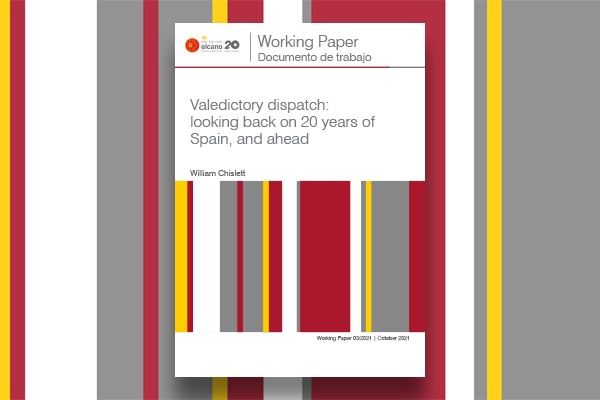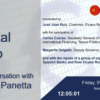Summary
In this Working Paper the author looks back on almost 20 years covering Spain for the Elcano Royal Institute and ahead to the country’s challenges.
Index
Introduction – 5
1. The background – 7
2. A political class holding back reform – 11
3. Quo vadis, Catalonia? – 21
4. Living with high unemployment – 27
5. Education: a lot of reforms but few meaningful results – 31
6. Demographic challenges: ageing and low fertility rate – 37
7. Pensions: kicking the can down the road – 41
8. Monarchy or Republic? – 45
9. Conclusions – 47
Bibliography – 49
Introduction
The author looks back on his almost 20 years covering Spain for the Elcano Royal Institute and ahead to the country’s challenges, loosely using as a model the forthright valedictory dispatches that British ambassadors write when leaving their post to take up duties elsewhere or retire.1
The past 20 years have seen further and sometimes profound changes in Spain. The country has its first coalition government since the 1930s; the Basque terrorist group ETA laid down its arms; the resident foreign population rose sixfold to 5.4 million (excluding nationalised Spaniards); and the stock of investment abroad quadrupled to US$625 billion, higher than Italy. Unemployment, however, has remained high at around 15% (11% in 2000), double the EU average, and the early school-leaving rate was still stark at 16%, though down from 31%.
The political class has become much more fragmented and polarised, making the structural reforms that Spain needs in areas such as pensions and the labour market difficult to achieve and deepening the distance between the moderation of citizens and the radicalism and intolerance of politicians in general. With the notable exception of Catalonia, Spanish society has not radicalised in the way the political class has.
(1) The background
Twenty years ago
- The Popular Party (PP) had been in in power for five years (for one year with an absolute majority after winning re-election in 2000).
- The Basque terrorist group ETA, responsible for more than 800 deaths, was still active.
- Catalonia had been ruled for 21 years by the nationalist Convergència i Unió (CIU) under Jordi Pujol.
- The number of resident foreigners (excluding nationalised Spaniards) stood at 896,000 (2.2% of the 40.5 million population)
- Congress condemned the 1936 military coup of General Franco (27 years after the dictator’s death), which sparked the three-year Civil War.
- The country was well into its credit-fuelled property boom, when a large part of the country lost touch with reality. This peaked at 725,000 housing starts in 2006 (more than Germany, France and the UK combined), not to mention the building of several ‘ghost’ airports, art centres and 11 new bullrings in the Madrid region.
- The early school-leaving rate reached 31% (EU average 17.6%).
- The stock of outward direct investment began to take off as Spanish multinationals spread their wings (US$143 billion in 2001).
- The economy grew by a brisk 3.9%.
- The unemployment rate was 10% (above the EU average of 7.6%).
- The fiscal deficit was 0.45% of GDP.
- Public debt stood at 51% of GDP.
Twenty years on
- The country is governed by its first coalition administration since the 1930s (and a minority one), led by the Socialists and with the hard left Unidas Podemos as its junior partner. Parliament is more diversified, as a result of the entry of the would-be centrist Ciudadanos and the hard-right VOX.
- ETA has laid down its arms (in 2017).
- Catalonia is ruled by the pro-independence Catalan Republican Left (ERC) and Junts per Catalunya (JxCat). Pujol and his seven children face trial for money laundering and tax crimes.
- The resident foreign population (excluding nationalised Spaniards) swelled to 5.4 million (11.3% of the 47.3 million population).
- The last public statue of Franco was removed (the dictator’s remains were moved from the Valley of the Fallen mausoleum in 2019).
- The number of housing starts was down to 87,500 in 2020.
- The early school-leaving rate stood at 16% (EU average 9.9%).
- The stock of outward investment ballooned to US$625 billion, higher than Italy.
- The economy shrank 10.8% because of the impact of COVID-19.
- The fiscal deficit hit 11% of GDP.
- Public debt soared to 120% of GDP.
- The jobless rate stands at around 15% (double the EU average).
In short, Spain has changed significantly in the last 20 years (see Figure 1).Figure 1. Spain statistical profile, 2000-20
| 2000 | 2005 | 2010 | 2015 | 2019 | 2020 | |
|---|---|---|---|---|---|---|
| Gross domestic product | ||||||
| GDP per capita (current prices US$, PPPs) | 23,900 | 29,220 | 31,590 | 34,940 | 42,600 | 38,390 |
| Government deficit & debt | ||||||
| Fiscal balance (% GDP) | -1.0 | +1.3 | -9.4 | -5.2 | -2.9 | -11.0 |
| Public debt (Maastricht, % GDP) | 66.5 | 50.7 | 66.8 | 99.3 | 95.5 | 120.0 |
| Taxes | 34.2 | 35.7 | 31.7 | 33.8 | 34.8 | NA |
| Total tax revenue (% GDP) | ||||||
| Trade | ||||||
| Imports goods & services (% GDP) | 31.5 | 29.8 | 27.0 | 30.6 | 31.9 | 29.1 |
| Exports goods & services (% GDP) | 28.6 | 25.0 | 28.0 | 33.6 | 34.9 | 30.6 |
| Curr. acc. balance (% GDP) | -4.0 | -7.3 | -4.5 | +2.0 | +2.1 | +0.7 |
| Foreign direct investment | ||||||
| Outward FDI stock (US$ bn) | 129.2 | 305.4 | 653.2 | 512.9 | 626.3 | 624.8 |
| Inward FDI stock (US$ bn) | 156.3 | 384.5 | 628.3 | 561.7 | 763.2 | 853.2 |
| Education | ||||||
| Lower secondary education or less (25-64 years, %) | 61.5 | 51.2 | 47.1 | 42.6 | 38.7 | 37.1 |
| Upper secondary education (25-65 years, %) | 15.8 | 20.2 | 21.9 | 22.4 | 22.7 | 23.2 |
| Tertiary attainment (25-64 years, %) | 22.7 | 28.5 | 31.0 | 35.1 | 38.6 | 39.7 |
| Early school-leaving rate (% of population 18-24) | 30.9 | 31.0 | 28.2 | 20.0 | 17.2 | 16.0 |
| Unemployment | ||||||
| Jobless rate (%) | 11.1 | 9.2 | 20.1 | 22.1 | 14.1 | 16.2 |
| Youth unemployment (% of those aged 15-24) | 25.2 | 19.7 | 41.5 | 48.3 | 32.6 | 36.9 |
| Research & Development | ||||||
| Expenditure (% of GDP) | 0.9 | 1.1 | 1.3 | 1.2 | 1.2 | NA |
| Population | ||||||
| Total (million) | 40.2 | 43.4 | 46.5 | 46.4 | 46.9 | 47.3 |
| Fertility rate | 1.2 | 1.3 | 1.4 | 1.3 | 1.24 | 1.18 |
| Under 15 (% of total population) | 14.7 | 14.5 | 15.0 | 15.1 | 14.6 | 14.6 |
| Over 65 (% of total population) | 16.8 | 16.7 | 17.0 | 18.6 | 19.6 | 20.0 |
| International migration | ||||||
| Foreign population (% of total) (1) | 2.2 | 9.5 | 12.3 | 9.4 | 11.0 | 11.3 |
| Health | ||||||
| Life expectancy at birth (years) | 79.4 | 80.3 | 82.2 | 82.9 | 83.6 | 82.3 |
| Society | ||||||
| International tourists (million) | 48.2 | 55.6 | 52.5 | 68.2 | 83.5 | 18.9 |
(1) Excluding naturalised Spaniards. Source: OECD, INE, Eurostat, WTO, UNCTAD
William Chislett
Senior Research Fellow, Elcano Royal Institute | @WilliamChislet3
1 These dispatches remain out of the public domain for at least 25 years. Most famously, the dispatch of Sir Nicholas Henderson, the outgoing British Ambassador to France, in March 1979, largely focused on Britain’s absolute decline relative to France and Germany and relative to the superpowers, was leaked to The Economist. Henderson predicted that if the UK’s trends continued Spain would overtake the UK in GDP per head by the end of the 20th century. It did not happen. The UK’s per capita GDP was $26,774 in 2000 (PPP) and Spain’s $23,905. I thank all my current and former colleagues at the Elcano Royal Institute, particularly Charles Powell and Emilio Lamo de Espinosa, for their help and encouragement over two decades. I also thank Joaquín Almunia for commenting on this text. Available at https://www.economist.com/news/1979/06/02/britains-decline-its-causes-and-consequences.



